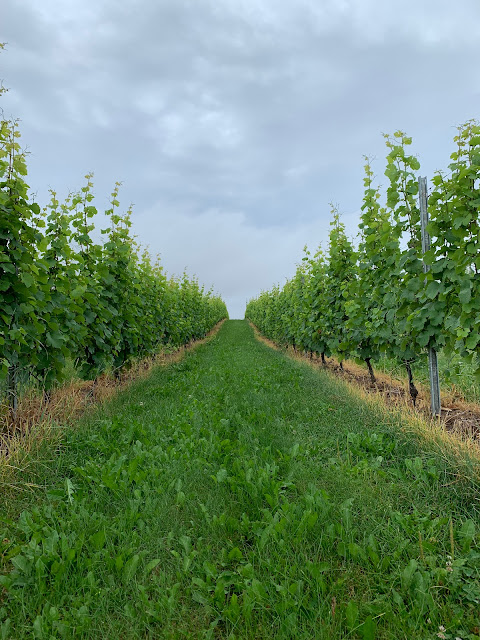The last couple of weeks the vineyards have received an important amount of precipitation, have been exposed to high humidity levels and warm conditions, including through the night. These conditions are ideal for the proliferation of Downy Mildew through the vineyard, keeping in mind that some varieties will be more susceptible than others. Symptoms may appear within 4-6 days in favourable conditions (optimum temperature is 18 – 25⁰ Celsius). Therefore, it’s necessary to scout the vineyard frequently these days, ideally at least 3 times per week, and keep a fungicide rotation to avoid developing resistance.
One the easiest and most important activities is scouting.
Scouting:
Vineyards should be monitored from early June to mid-September,
with more frequent scouting between now in July to August and depending on the
location until mid-September.
- When: from first leaves unfolded (stages 5-7), particularly during periods of rain, heavy dew, and persistent fog at a temperature above 11°C. As previously mentioned, three times per week is recommended with high pressure.
- Where: Downy Mildew develops in shaded parts of the canopy. Special attention should be given to wet areas with heavy soils, poor drainage, depressions, and abundant foliage.
- How: The appearance of characteristic “oil spots” on the upper leaf surface should be monitored. Check the lower surface of necrotic lesions for the presence of cottony white sporulation of the fungus.
Confused with:
Downy mildew can be confused with powdery mildew, which is
caused by another fungal pathogen. The cottony white sporulation in the case of
downy mildew is on the lower surface of the leaves, whereas powdery mildew’s sporulation
is on the upper leaf surface. In addition, powdery mildew does not produce
angular necrotic lesions on the infected leaves.
Management:
Once the disease has been properly identified, before mentioning
some products, it’s important to highlight:
- Scout the most vulnerable varieties at the locations with lower air flow, more humidity, warmer conditions, and the areas where in previous years the diseases have been found.
- Spraying again might be necessary in some of the products applied, as contact ones might be washed depending on the amount of precipitation received in the area. Therefore, look at the date of your last application before you decide to move forward.
- Remember to rotate products with the same group to avoid creating disease resistance, pay attention to the re-entry time and keep an eye on the forecast, especially precipitation.
Products to consider:
A couple of options for organic and conventional producers
to manage Downy Mildew.
In the case of organic producers, the most known are contact
products derived from copper.
- Copper 53 W (active ingredient tri-basic copper sulphate)
- Kocide 2000 (active ingredient copper hydroxide)
- Cueva (active ingredient copper octanoate)
- Copper spray (active ingredient copper hydroxide)
- Guardsman Copper Oxychloride 50 (active ingredient copper hydroxide)
Other contact options are OxiDate (active ingredient hydrogen
peroxide + peroxyacetic acid) and Timorex Gold (active ingredient tea
tree oil).
In terms of more systemic action, there is:
- LifeGard WG (active ingredient Bacillus mycoides isolate J)
Figure 3. Leaves with chemical damage.
Meanwhile, for conventional producers, it’s possible
to find more options. Locally systemic products with their group in parenthesis
are:
- Torrent (group 21)
- Pristine (group 7+11)
- Sovran (group 11)
- Phostrol (group P7)
- Rampart (group P7)
- Confine Extra (group P7)
- Aliette (group P7)
- Revus (group 40)
- Forum (group 40)
- Zampro (group 40+45)
Moreover, exist contact products as well, such as:
- Diplomat 5 SC (active ingredient polyoxin D zinc salt)
- Gavel DF (active ingredient zoxamide + mancozeb)
- Dithane Rainshield (active ingredient mancozeb)
- Manzate Max (active ingredient mancozeb)
- Manzate Pro-stick (active ingredient mancozeb)
- Follow WDG (active ingredient folpet)
- Folpan 80 WDG (active ingredient folpet)
These are some options to consider at the time to manage
Downy Mildew in the vineyard. You can reach your local supplier to learn from
other products available in the market.
Attention: before any application, carefully read
the label to see the maximum rates, groups of each fungicide, maximum number
of applications per season and Restricted Entry Interval (REI) times before
working in the vineyard. It’s important to rotate products with the same group
to avoid creating resistance.
Last, but not least, to find more information related to
Downy Mildew and other diseases, please take a look to the Grape
Production guide from page 53.




